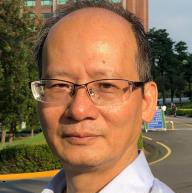Keynote Speaker

Prof. Dr. Chih-Huang Weng
Professor, Department of Civil Engineering, I-Shou UniversitySpeech Title: Energy- and Materials-activated Persulfate Processes for Degradation of Organic Contaminants
Abstract: Advanced oxidation processes (AOPs) using strong oxidizing radicals, mainly sulfate (SO4•–) and hydroxyl radicals (HO•), are frequently studied for degradation of refractory organic contaminants. Among the AOPs process, persulfate (PS) activation technology has gained considerable attention for removal of organic contaminants owing to its superior oxidant power, high stability at room temperature, having a much longer lifetime of reactivity compared with HO• radicals, and maintaining reactive over a wide range of pH. Peroxydisulfate (S2O82–, PDS) and peroxymonosulfate (HSO5–, PMS, monopersulfate) are commonly used in generating SO4•– radicals. PDS has a better potential for application over PMS due to its stability, long environmental retention time, and low cost. The effectiveness of PS activation technology is depending upon the activation methods. This presentation highlights the ways employed for activation of PS to generate SO4•–, including base activation, energy (electrical) activation, and materials activation. Energy-based activation, i.e., heat, ultrasound, microwave, and ultraviolet light, are commonly used for initiating the formation of SO4•– radicals. A materials-based activation consumes less energy and requires simpler reactor configuration as compared to the energy-based activation. Carbon-based materials and transition metals are frequently used as activators. Soil organic matters and glucose can also activate the persulfate. Such practices are quite interest in the in situ chemical oxidation of contaminated soils and groundwater. The newly developed magnetic materials, such as nFe3O4/biochar, magnetic Fe3O4/montmorillonite, Fe3O4-α-MnO2, and γ-Fe2O3/Mn3O4 nanocomposites is briefly introduced in terms of their effectiveness and practical applicability. This presentation also of particular focuses on PS activation via nano-sized Fe0 (nZVI), Fe0 aggregates, and Fe-containing minerals (biotite, tourmaline, pyrite, mackinawite, and greigite). Of particular interest is the feasibility of using ultrasound and heat as enhancement tools in the activated-PS system. The indispensable operating factors affecting such process is discussed and further exemplified by studies of degradation of azo dyes. Generally, a pseudo-first-order reaction kinetic model is adopted to characterize the rate of degradation. This presentation provides an overview of PS-based AOPs for contaminant removal from aqueous solution and particularly for the understanding of the activation methods, influential parameters, and enhancement tools in the application of this technology.
Biography: Dr. Chih-Huang Weng is a Full Professor in the Department of Civil and Ecological Engineering at I-Shou University, Taiwan. He also serves as Vice President of North Kaohsiung Community University, Kaohsiung City. He received his MS and Ph.D. degrees in 1990 and 1994, respectively, from the Department of Civil Engineering of The University of Delaware, USA. He has published around 90 papers in SCI journals and 36 of them H-index with 4336 citations in Mendeley database. He serves as the editor, editorial board member, and guest editor of several academic journals, such as Agricultural Water Management, Coloration Technology, Environmental Geochemistry and Health, and Environmental Science and Pollution Research. He has also organized and chaired several international conferences. His main research interests focus on using advanced oxidation processes and adsorption for the treatment of wastewater and bacteria inactivation, ground water modeling, and application of electrokinetic technologies to soil remediation/sludge treatment/activated carbon regeneration.